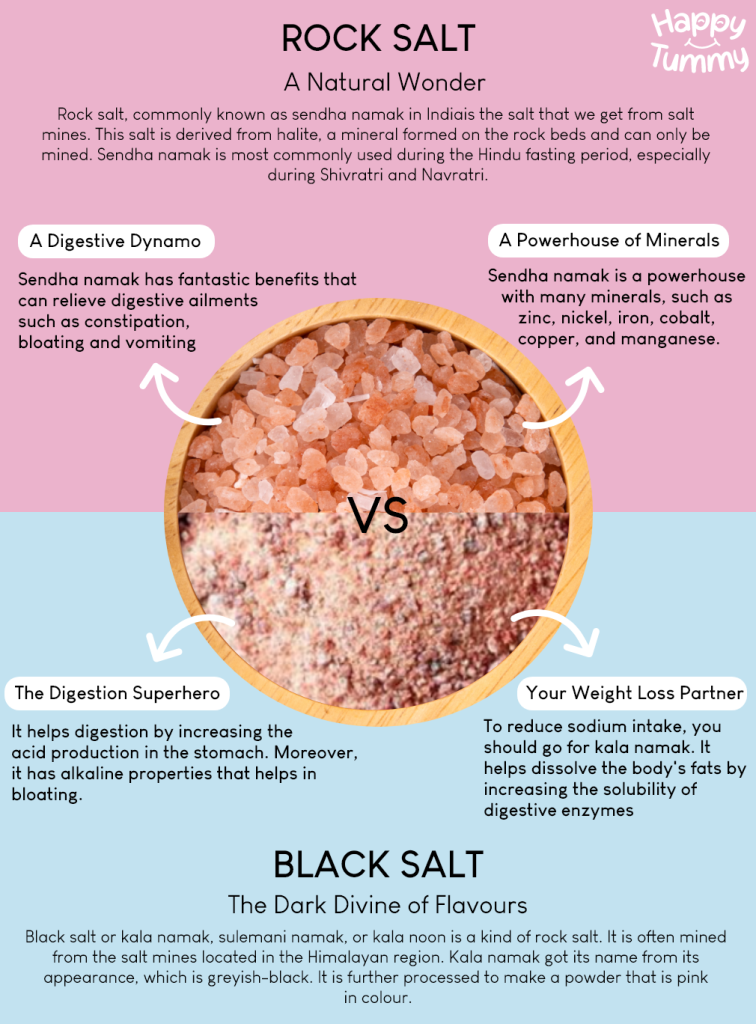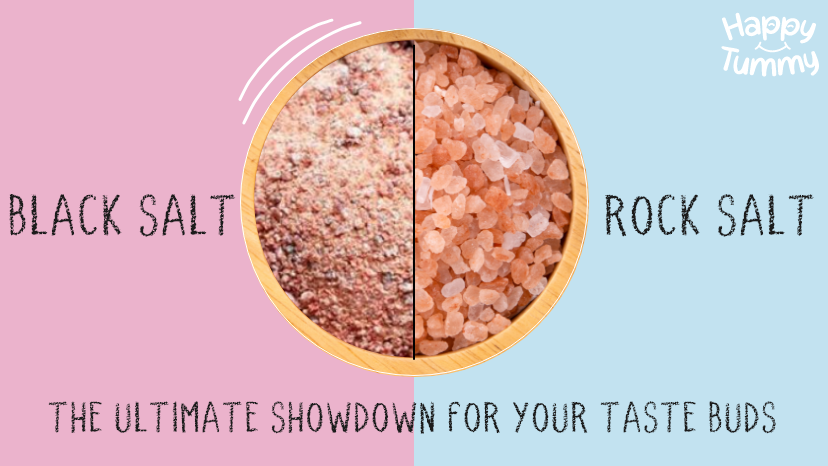Table of Contents
Here is an interesting question for all the foodies: Can you figure out the type of salt used in your meals by tasting it? Thinking, why are we asking you this simple question? After all, salt is salt. That’s where a lot of people make mistakes in identifying black salt and rock salt.
Salt is not just any salt, but it has many different varieties.
Today, we’re diving deep into the flavourful universe of salts as we pit two contenders against each other in an epic clash. We have the enigmatic Black Salt in one corner, mysterious and full of surprises.
And in the opposing corner, we have the rugged and dependable Rock Salt, a stalwart of seasoning.
Let’s look at both of these and figure out how they are different from each other. So, next time you decide on a meal, you will be able to determine which salt to use.
Know Everything About Your Regular Salt
Before discussing black and rock salt, we should know something about salt. Salt, a powerful flavouring agent in every Indian recipe, can be extracted from two primary sources – salt mines and sea.
The salt obtained from the sea is white and must undergo much processing before it reaches our kitchen. In this process, iodine is added and hence, iodized salt.
Rock Salt – A Natural Wonder
Rock salt is the salt that we get from salt mines. This salt is derived from halite, a mineral formed on the rock beds and can only be mined. Rock salt, commonly known as sendha namak in India, comes in several varieties.
This salt has a very high value in Ayurveda and is believed to have many health benefits [1].
Sendha namak is most commonly used during the Hindu fasting period, especially during Shivratri and Navratri.
Here are some of the benefits of using rock salt:
#1. Rock Salt – A Digestive Dynamo
Sendha namak is derived from rock beds and has fantastic benefits that can heal your digestive tract and rejuvenate your digestive capacities.
During Ayurveda, sendha namak was used to relieve digestive ailments such as constipation, bloating and vomiting [2].
Sendha namak is often added to curd, especially lassi, which cools the stomach and aids in healthy digestion, thus creating a happy tummy.
If you wish to know more about how well is your digestive system, try the digestive quotient test made by Aashirvaad Atta with Multigrain.
#2 Sendha Namak – A Powerhouse of Minerals
Sendha namak is a powerhouse with many minerals, such as zinc, nickel, iron, cobalt, copper, and manganese [3]. Your body also requires these in addition to the sodium chloride present in the table or regular salt.
These minerals also give different colours to sendha namak.
Black Salt – The Dark Divine of Flavours
Black salt or kala namak, sulemani namak, or kala noon is a kind of rock salt.
It is often mined from the salt mines located in the Himalayan region. Kala namak got its name from its appearance, which is greyish-black. It is further processed to make a powder that is pink in colour.
Kala namak has been used in Indian cuisine for a long time and is added to chutneys, salads, chaats, and curries. Let’s look at some of its health benefits:
#1. Kala Namak – The Digestion Superhero
Kala noon is an excellent remedy for digestive issues [4]. It helps digestion by increasing the acid production in the stomach. Moreover, it has alkaline properties that help neutralize the stomach’s excessive acids that result in bloating.
Consuming kala namak can help reduce the bloating and vomiting conditions.
Black salt also has laxative properties that support healthy bowel movements.
It can aid in softening the hard stool and making bowels easier. Thus, it can provide relief to people with constipation problems, making their tummy a happy tummy.
#2. Kala Namak – Your Weight Loss Partner
If you want to reduce sodium intake, you should go for kala namak. It helps dissolve the body’s fats by increasing the solubility of digestive enzymes [5]. Kala namak also speeds up digestion while providing extra nutrition to your body cells.
You can start your day by drinking lemon water with a pinch of kala namak for a healthy weight loss journey.

Final Thoughts – Black and Rock Salt
One fantastic property that both these salt possess is their low sodium content. Rock salt is derived from the salt mines by harvesting the salt on the rock beds.
On the other hand, kala namak is a form of sendha namak crushed to a powder form.
With unique flavour, texture and taste, both these salt are a great addition to your kitchen, and you can choose your favourite depending on your taste preference.
FAQs
Both rock salt and black salt have low sodium content as compared to regular salt. Therefore, these salts can be great for people who wish to reduce their sodium intake.
Kala namak is a form of sendha namak derived from the salt mines of the Himalayan region in particular. They both have distinct smells and tastes, even though they come from the rock beds’ salt mines.
Yes, it can easily be used to cook Indian and Asian cuisines. It has a very pungent, umami and savoury flavour. These days it is also used in vegan cooking to provide a taste similar to that of eggs.
Pink salt is often referred for rock salt because of its colour. The rock salt gets its unique colour due to various minerals such as zinc, nickel, manganese, copper, and others present in it.















